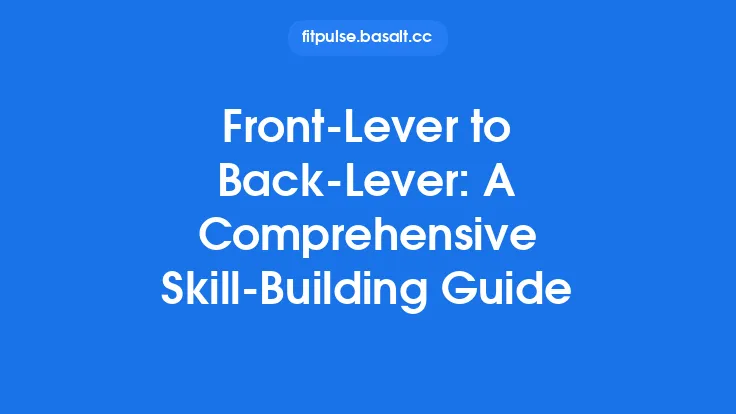The journey from a tucked planche to a full‑blown straddle planche is one of the most rewarding pathways in bodyweight training. It blends raw strength, precise motor‑control, and refined mobility into a single, elegant skill. While the end goal looks spectacular, the process is built on a series of well‑defined, repeatable steps that can be programmed for athletes of any level. Below is a systematic, evergreen framework that breaks the progression into clear phases, outlines the essential conditioning work, and provides practical guidelines for tracking progress and staying injury‑free.
1. Foundations: Building the Structural Base
Before attempting any planche‑specific work, you need a solid structural foundation. This phase focuses on three pillars: wrist/shoulder stability, core rigidity, and posterior‑chain tension.
| Pillar | Primary Goal | Key Exercises | Reps / Sets | Frequency |
|---|---|---|---|---|
| Wrist & Forearm | Increase joint tolerance, develop grip endurance | Wrist push‑ups, reverse wrist curls, fingertip holds on parallettes | 3 × 30‑45 s | 3‑4 × week |
| Scapular Control | Master scapular depression/elevation cycles | Scapular push‑ups, band‑pull‑aparts, wall slides | 4 × 12‑15 | 3‑4 × week |
| Core & Hip | Create a rigid “board” for the planche | Hollow body holds, reverse crunches, glute bridges (single‑leg) | 4 × 20‑30 s | 4‑5 × week |
| Posterior Chain | Maintain tension throughout the body | Romanian deadlifts (light), Nordic curls, reverse hyperextensions | 3 × 8‑10 | 2‑3 × week |
Progression cue: Only move on once you can hold each core/hollow position for at least 45 seconds with a neutral spine and without excessive lumbar arching.
2. Tuck Planche Mastery
The tucked planche is the first true “planche” position. It isolates the shoulder‑pressing component while allowing the hips to stay close to the torso, reducing lever length.
2.1. Technique Breakdown
- Hand Placement – Parallel bars or parallettes, hands shoulder‑width apart, fingers slightly turned outward to engage the forearm rotators.
- Body Position – Knees tucked tightly to the chest, hips flexed, back rounded slightly (maintain a “hollow” torso).
- Weight Distribution – 60‑70 % on the hands, the remainder on the toes; the elbows stay locked.
- Breathing – Inhale to set tension, exhale while holding the position to maintain intra‑abdominal pressure.
2.2. Progressive Load Scheme
| Level | Description | Hold Time Goal | Progression Cue |
|---|---|---|---|
| Static Tuck | Full tuck, feet off the ground | 10 s → 30 s | Add a light weight vest (≤ 2 kg) once 30 s is comfortable |
| Dynamic Tuck | Tuck hold + slow “push‑up”‑like elevation (0‑2 cm) | 5 s per rep, 3‑5 reps | Increase range gradually; keep elbows locked |
| Weighted Tuck | Add external load (vest, plate) | 10 s → 20 s | Increment load by 1 kg once hold is stable |
Training Frequency: 3‑4 dedicated planche sessions per week, interspersed with the foundational work from Phase 1. Use a “hard‑soft” approach: 2 hard days (max effort holds) + 1 soft day (light technique work, mobility).
3. Advanced Tuck & Straddle Transition
Once the static tuck is reliable, the next step is to increase lever length by extending the hips while still keeping the knees relatively close. This is the “advanced tuck” and the gateway to the straddle.
3.1. Mobility Prerequisites
- Hip Abduction Flexibility: Perform standing straddle stretches, frog stretches, and seated straddle holds for 2‑3 minutes each session.
- Hamstring & Adductor Balance: Dynamic leg swings (front‑back & side‑to‑side) to maintain length‑tension equilibrium.
3.2. Skill Drills
| Drill | Execution | Sets / Reps | Focus |
|---|---|---|---|
| Advanced Tuck Hold | Same hand placement, but extend knees outward slightly (≈ 30°) while keeping thighs parallel to the ground | 4 × 15‑20 s | Hip abduction control |
| Tuck‑to‑Straddle Negatives | Start in a full straddle planche (or assisted), slowly lower hips back into an advanced tuck, then to a tuck | 3 × 3‑5 reps | Controlled eccentric strength |
| Straddle Planche Leans | From a plank, lean forward while keeping legs in a wide straddle, stop when shoulders are over hands | 5 × 10‑15 s | Shoulder‑press strength, balance |
Progression Cue: When you can hold the advanced tuck for 30 seconds with minimal hip wobble, begin integrating the leans and negatives.
4. Straddle Planche Development
The straddle planche reduces the load on the shoulders by spreading the weight across a wider base of support, making it the most accessible full‑planche variation for most athletes.
4.1. Structural Requirements
- Shoulder Flexibility: Wall‑supported shoulder dislocates, banded shoulder pass‑throughs (3‑4 × 15 reps).
- Scapular Depression Strength: Weighted scapular depressions (band or cable) 3 × 8‑10.
- Core Lateral Stability: Side‑plank holds with leg lift (30 s each side) to reinforce the lateral tension needed for the straddle.
4.2. Core Progression Scheme
| Stage | Exercise | Load / Angle | Hold Time | Sets |
|---|---|---|---|---|
| Isometric Straddle | Hands on parallettes, legs spread, hips lifted, knees slightly bent | Bodyweight | 5 s → 20 s | 4‑5 |
| Partial Straddle | Same as above, but raise hips higher (≈ 30°) | Bodyweight | 3 s → 12 s | 4 |
| Full Straddle | Legs fully extended, hips at 90°, shoulders over hands | Bodyweight (or light vest) | 2 s → 10 s | 3‑4 |
Key Cue: Keep the pelvis tucked (neutral) and actively engage the glutes to prevent excessive lumbar arch.
4.3. Programming Blueprint
| Week | Focus | Main Set | Accessory Work |
|---|---|---|---|
| 1‑2 | Tension & Mobility | Advanced Tuck Holds (4 × 20 s) + Straddle Leans (5 × 10 s) | Wrist conditioning, scapular push‑ups |
| 3‑4 | Transition | Tuck‑to‑Straddle Negatives (3 × 4) + Isometric Straddle (4 × 10 s) | Hip abduction drills, hollow holds |
| 5‑6 | Strength | Partial Straddle Holds (4 × 12 s) + Weighted Advanced Tuck (3 × 15 s) | Band‑resisted shoulder depressions |
| 7‑8 | Consolidation | Full Straddle Holds (3 × 8‑12 s) + Negatives (3 × 3) | Core lateral stability, glute bridges |
| 9+ | Mastery & Variation | Add dynamic straddle planche push‑ups, planche to handstand combos | Continue mobility, deload every 4‑5 weeks |
Recovery: Incorporate at least one full rest day after two consecutive planche‑heavy sessions. Use active recovery (light mobility, foam rolling) to maintain joint health.
5. Common Pitfalls & How to Avoid Them
| Pitfall | Symptom | Corrective Action |
|---|---|---|
| Early Wrist Overload | Pain on the palmar side, swelling | Add wrist extension stretches, use parallettes with a slight angle, limit hold time until tolerance builds |
| Hip Sagging | Lower back arches, loss of tension | Reinforce hollow body cues, engage glutes, practice “hip tuck” drills on the floor |
| Shoulder Impingement | Discomfort during leans, limited range | Strengthen rotator cuff with external rotations, increase scapular depression work |
| Insufficient Hip Flexibility | Inability to spread legs wide enough for straddle | Daily straddle splits, PNF stretching, dynamic leg swings |
| Progression Jumping | Stalling or regression after moving to a harder variation | Use the “two‑week rule”: stay at a level for at least two weeks before advancing, unless you can exceed the hold criteria by 20 % |
6. Tracking Progress & Objective Metrics
- Hold Duration Log: Record the longest clean hold for each variation (tuck, advanced tuck, straddle).
- Load Increment Chart: Note the weight added (vest, plate) and the corresponding hold time.
- Mobility Benchmarks: Measure straddle split distance (cm) and shoulder pass‑through range (degrees) every four weeks.
- Video Review: Capture a side‑on and frontal view of each hold; assess scapular positioning, hip angle, and wrist alignment.
A simple spreadsheet with columns for Date, Variation, Hold Time, Load, Mobility Score provides a clear visual of trends and helps decide when to progress.
7. Periodization & Long‑Term Planning
A well‑structured macrocycle (12‑16 weeks) should alternate between strength‑focused blocks (higher load, lower volume) and skill‑focused blocks (lower load, higher volume of holds). Example:
- Weeks 1‑4 (Hypertrophy/Strength): Weighted advanced tuck, scapular depressions, 4‑5 × week.
- Weeks 5‑8 (Skill & Endurance): High‑frequency isometric straddle holds, leans, 5‑6 × week, minimal external load.
- Weeks 9‑12 (Peaking): Full straddle planche attempts, dynamic push‑ups, taper load in the final week.
Deload weeks (reduce volume by 40‑50 %) every 4‑6 weeks prevent overuse injuries and keep neuromuscular adaptations fresh.
8. Nutrition & Recovery Essentials
- Protein: Aim for 1.6‑2.2 g · kg⁻¹ body weight daily to support tendon and muscle repair.
- Omega‑3s: 1‑2 g EPA/DHA per day can reduce inflammation in the wrists and shoulders.
- Sleep: Minimum 7‑9 hours; deep sleep is critical for connective‑tissue remodeling.
- Supplements (optional): Collagen peptides (10 g) with vitamin C, magnesium (300‑400 mg) for muscle relaxation.
9. Putting It All Together – A Sample 8‑Week Microcycle
| Day | Main Focus | Primary Exercise | Accessory / Mobility |
|---|---|---|---|
| Mon | Tension & Strength | Weighted Advanced Tuck Holds (4 × 20 s) | Wrist push‑ups, scapular depressions |
| Tue | Mobility & Core | Straddle Split Stretch (3 × 2 min) + Hollow Holds (4 × 30 s) | Hip abduction band walks |
| Wed | Rest / Active Recovery | Light cardio, foam roll | Shoulder pass‑throughs (band) |
| Thu | Skill & Endurance | Straddle Planche Leans (5 × 12 s) | Glute bridges, side‑plank |
| Fri | Strength | Weighted Tuck‑to‑Straddle Negatives (3 × 4) | Reverse curls, band pull‑aparts |
| Sat | Full‑Body Conditioning | Circuit: Pull‑ups, dips, pistol squats (3 × 8) | Dynamic leg swings |
| Sun | Rest | — | Gentle yoga, breathing work |
Repeat the cycle, adjusting hold times and load based on the metrics logged in Section 6.
Final Thought
The transition from a tucked planche to a straddle planche is less about raw brute force and more about mastering a cascade of micro‑skills—wrist resilience, scapular stability, core rigidity, hip mobility, and precise body tension. By adhering to the systematic framework outlined above, you create a repeatable, measurable pathway that can be scaled, regressed, or deloaded as needed. Consistency, patience, and diligent tracking are the true catalysts that will turn the seemingly impossible straddle planche into a reliable component of your calisthenics repertoire. Keep the fundamentals strong, respect the body’s recovery signals, and enjoy the elegant progression one hold at a time.





